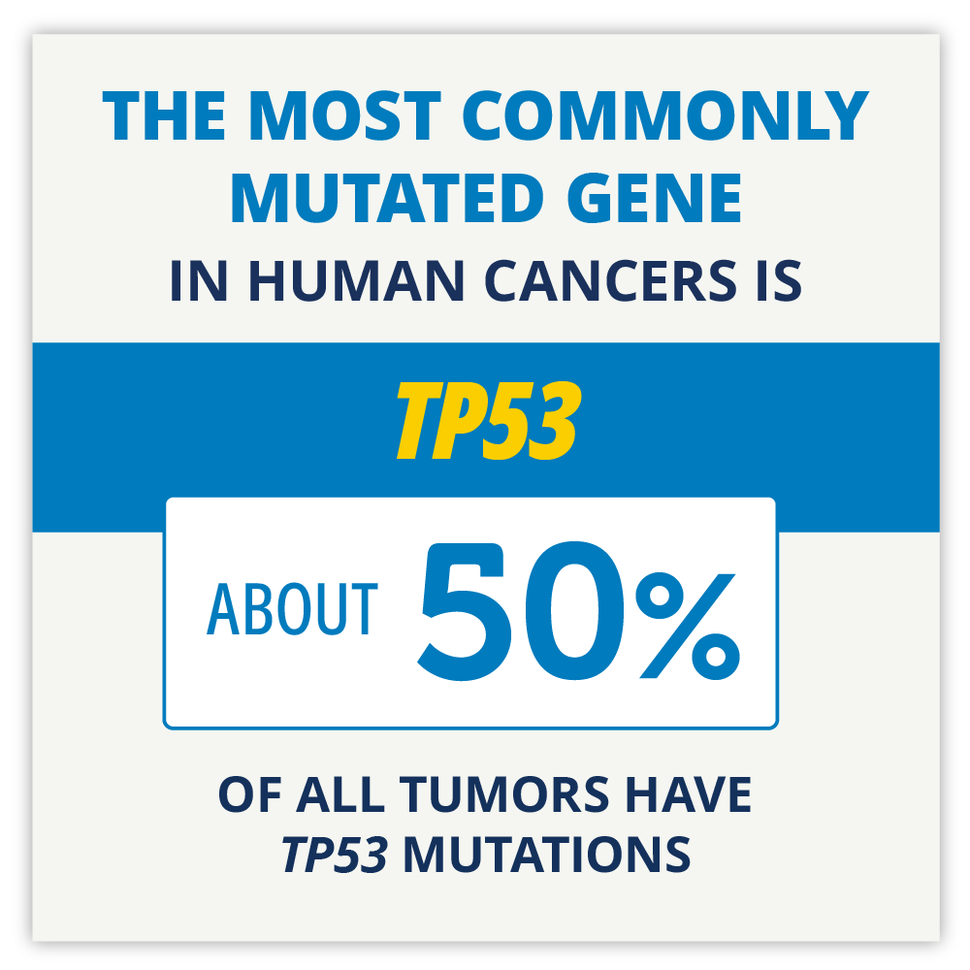Drug Combination May Have Potential for Cancers with TP53 Mutations
, by Nadia Jaber
Researchers have identified a drug combination that selectively kills cancer cells with mutations in the TP53 gene. Such mutations are found in more than half of all cancers, including most colorectal and pancreatic cancers.
In a study partially funded by NCI, the two-drug combination slowed the growth of colorectal and pancreatic tumors with TP53 mutations in mice. Both drugs are already used on their own to treat cancer.
TP53 is often called “the guardian of the genome” because it coordinates the repair of damaged DNA, preventing potentially harmful mutations from building up, explained study co-leader Andrei Bakin, Ph.D., of Roswell Park Comprehensive Cancer Center in Buffalo, NY.
Cancer cells with missing or mutated TP53 lack this safeguard, so they rapidly acquire DNA changes that give them a leg up for growing and spreading, Dr. Bakin added. But TP53 mutations also put cancer cells at a disadvantage because they can’t handle as much DNA damage as cells with normal TP53. Too much DNA damage often kills cells.
The drug combination tested in the study exploits that weakness, using Lonsurf (previously called TAS-102) to damage DNA and talazoparib (Talzenna), a drug called a PARP inhibitor, that prevents cells from repairing DNA breaks.
The combination worked better to kill TP53-mutant cancer cells and shrink tumors in mice than either drug alone, without increasing side effects, the researchers reported February 21 in Cell Reports Medicine.
Based on their findings, the team has launched an ongoing clinical trial of Lonsurf and talazoparib in people with advanced colorectal or gastroesophageal cancer.
“We hope that we will publish the initial results [of this trial] within the next couple of months,” said study co-leader Christos Fountzilas, M.D., also of Roswell Park.
Lack of drugs targeting p53
Although TP53 mutations help propel the growth of most cancers, there are no FDA-approved therapies that target altered p53 proteins. But that isn’t for lack of trying. In the past, scientists devised clever strategies that shrank TP53-mutant cancers in lab studies.
“But when they advanced those [ideas] into [clinical trials], they didn't live up to their potential,” said Ron Johnson, Ph.D., of NCI’s Division of Cancer Biology, who wasn’t involved in the new study.
There are many reasons for that, one being the diversity of TP53 mutations in cancers, Dr. Johnson explained. There are hundreds of known TP53 mutations. Some alterations inactivate the p53 protein entirely, while others strip p53 of its normal functions and give it new functions.
It’s “challenging to find a strategy that’s broadly effective against these different [mutations],” he said.
Researchers worldwide are currently testing several new strategies intended to target TP53-mutant cancers, including drugs that restore the normal function of altered p53 proteins or that teach immune cells to attack TP53-mutant cancer cells. Some of these approaches are currently being tested in clinical trials.
But for now, when routine biomarker testing picks up a TP53 mutation in a person’s tumor, doctors don’t have any matching targeted therapies to give the patient, Dr. Fountzilas said.
Talazoparib enhances the effects of Lonsurf
Lonsurf is an approved treatment for metastatic colorectal cancer. However, a study found that Lonsurf has significantly less activity in TP53-mutant tumors than in tumors with normal TP53, Dr. Fountzilas noted.
The researchers wondered whether they could enhance Lonsurf’s effects on TP53-mutant cancers.
Lonsurf and other drugs called thymidine analogs cause breaks in DNA that stop cancer cell growth. As cells try to repair the DNA damage, they rely on a group of enzymes called PARP.
The scientists reasoned that PARP inhibitors—drugs that block the activity of PARP enzymes—might be the ticket to improving Lonsurf’s effects. Several PARP inhibitors are used to treat cancer, including talazoparib and olaparib (Lynparza). PARP inhibitors are often used to treat cancers with BRCA gene mutations which, like TP53 mutations, hamper DNA repair.
Experiments with colon cancer cells lacking TP53 or pancreatic cancer cells with mutant TP53 growing in lab dishes confirmed the team’s idea that combining Lonsurf and talazoparib killed more cancer cells than Lonsurf alone.
Lab experiments also indicated that talazoparib and Lonsurf had a synergistic effect, meaning that the effects of the combination were greater than the sum of the effects of each individual drug.
This synergy lowered the amount of Lonsurf needed to kill TP53-mutant cancer cells, the researchers found.
Synergy is “not a must-have for drug combinations, but when you see that in [laboratory] studies it gives you a stronger feeling that it may be an effective treatment,” Dr. Johnson explained.
Slowing the growth of p53-mutant tumors
When the research team tested the Lonsurf–talazoparib combination in mice with colorectal tumors with normal TP53, it had about the same effect on tumor growth and survival as either drug alone.
But in mice with TP53-mutant colorectal or pancreatic tumors, the combination substantially slowed tumor growth, whereas either drug alone had no effect or very limited effect. The combination also appeared to trigger much more DNA damage and cell death than either drug alone.
As a result, mice with TP53-mutant tumors treated with the combination lived longer than those treated with either drug alone. And the combination didn’t appear to cause any significant side effects.
The team saw similar outcomes with the combination of Lonsurf and olaparib.
“Achieving synergy without also increasing toxicities is one of the holy grails of cancer treatment,” Dr. Fountzilas noted.
However, “both these compounds do interfere with DNA repair,” Dr. Johnson cautioned. “The [laboratory] studies show that the [normal] cells can deal with the damage, but there might be concerns as you move into [clinical trials].”
Separately, both Lonsurf and PARP inhibitors are known to damage blood cells, and in rare cases, PARP inhibitors can lead to certain kinds of blood cancer.
Although the researchers tested the drug combination only in mice with colorectal or pancreatic tumors, the approach could work for other types of cancers with TP53 mutations, Dr. Johnson said.
A treatment that’s effective against a broad range of cancers with TP53 mutations “would be very powerful,” he said.
That could include people with Li-Fraumeni syndrome, who are born with TP53 mutations and have a higher risk of developing certain cancers, Dr. Bakin pointed out. “Our work brings hope to these [people] as well,” he said.
Clinical trial of Lonsurf plus talazoparib
The goal of the ongoing clinical trial of Lonsurf and talazoparib is to find the optimal dose of the drug combination and evaluate its side effects. This part of the trial is not limited to people with TP53-mutant tumors, Dr. Fountzilas noted.
The next phase of the trial will enroll only people with TP53-mutant colorectal cancer and will determine whether the treatment shrinks tumors. If the initial results are positive, the researchers hope to expand the trial to include people with TP53-mutant pancreatic and breast cancer.
The researchers are also bringing data and materials from the clinical trial back to the lab to learn more about “who's going to get [the most] benefit from this treatment,” Dr. Fountzilas added.
Their ongoing lab studies have already identified expression levels of several genes that appear to make the combination treatment work better. Separate experiments have identified additional medicines that might further enhance the effects of the Lonsurf–talazoparib combination, Dr. Bakin said.

